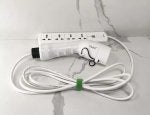Well since owning the car I have been looking at the V2L dongle and wonder how it does what it does.
Looking at the unit I suspected that there couldn't be a whole lot going on because it didn't weigh too much.
With that in mind I thought it was fair to assume that the car did the heavy lifting in providing the angry pixies to allow us to dry the dog or boil a kettle or whatever it is you have done with V2L. and the dongle is just the means of connecting car to load and activating the Inverter in the car and allowing us the voltage output by the inverter.
So curiosity got the better of me today and i pulled it apart.
The main findings were that the dongle is indeed nothing more than a conduit from car to load with a switch to activate the inverter.
It activates the inverter by firstly telling the car there is something plugged into the charging port, This is done a circuit between between PP and PE with a 62 ohm resistance
Then when we operate the switch the CP line is also connected back to PE through the switch and thermal fuse which then tells the car to lock in the V2L dongle and switch on the inverter. Again this circuit has a resistance of 62 ohm
It's a pretty simple setup really with only a switch, a led and a thermal fuse to stop supply if the V2L socket gets too hot.
![Image]()
![Image]()
![Image]()
![Image]()
![Image]()
![Image]()
![Image]()
![Image]()
![Image]()
![Image]()
Looking at the unit I suspected that there couldn't be a whole lot going on because it didn't weigh too much.
With that in mind I thought it was fair to assume that the car did the heavy lifting in providing the angry pixies to allow us to dry the dog or boil a kettle or whatever it is you have done with V2L. and the dongle is just the means of connecting car to load and activating the Inverter in the car and allowing us the voltage output by the inverter.
So curiosity got the better of me today and i pulled it apart.
The main findings were that the dongle is indeed nothing more than a conduit from car to load with a switch to activate the inverter.
It activates the inverter by firstly telling the car there is something plugged into the charging port, This is done a circuit between between PP and PE with a 62 ohm resistance
Then when we operate the switch the CP line is also connected back to PE through the switch and thermal fuse which then tells the car to lock in the V2L dongle and switch on the inverter. Again this circuit has a resistance of 62 ohm
It's a pretty simple setup really with only a switch, a led and a thermal fuse to stop supply if the V2L socket gets too hot.













